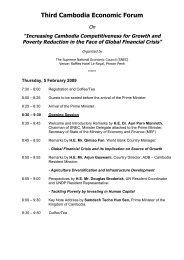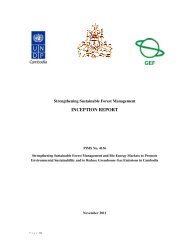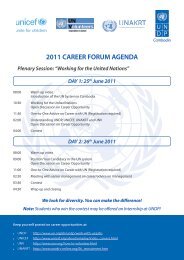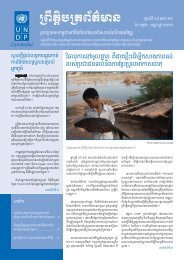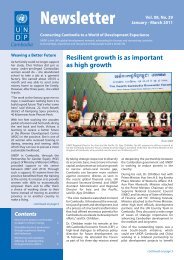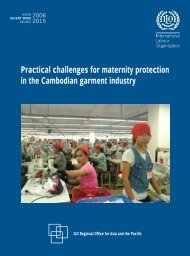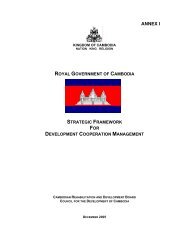UN Analysis Final.pdf - United Nations in Cambodia
UN Analysis Final.pdf - United Nations in Cambodia
UN Analysis Final.pdf - United Nations in Cambodia
Create successful ePaper yourself
Turn your PDF publications into a flip-book with our unique Google optimized e-Paper software.
4.2.2 YOUTH AND EDUCATION ATTENDANCE, HOW IT IMPACTS ON YOUTH LIVELIHOODS<br />
Table 4-3. Young people aged 5-24 currently attend<strong>in</strong>g school, by level and region (%)<br />
Level<br />
Regions<br />
Phnom Penh Other Urban Rural<br />
Primary 46.2 66.5 80.1<br />
Lower Secondary 22.6 19.3 13.9<br />
High school 15.6 10.9 4.0<br />
Technical/Vocational 2.4 1.0 0.2<br />
Under Graduate/ Graduate 9.9 1.1 0.3<br />
Other 1.7 0.1 0.2<br />
Total 100.0 100.0 100.0<br />
Source: CSES 2004<br />
4.2.3 EARLY SCHOOL-LEAVING: A MAJOR BARRIER TO YOUTH EMPLOYMENT OPPORT<strong>UN</strong>ITIES<br />
One of the biggest problems cited <strong>in</strong> relation to education <strong>in</strong> <strong>Cambodia</strong> is high attrition rates 19 for Grades<br />
1-9 (MoEYS 2008). The National Strategic Development Plan Progress Report for 2006 notes that “these<br />
unwanted trends arise from a high level of repetition and drop-out at these two levels.” 20 Because of<br />
this, MoEYS has focused on a large school facilities development programme to respond to <strong>in</strong>complete<br />
primary schools and to br<strong>in</strong>g educational service delivery opportunities closer to children’s homes.<br />
The school curriculum is also be<strong>in</strong>g revamped <strong>in</strong> order to improve the relevance of education, particularly <strong>in</strong><br />
the area of life skills, and to discourage school dropout. School re-entry schemes are also be<strong>in</strong>g piloted on a<br />
small scale. Major reasons for leav<strong>in</strong>g school early <strong>in</strong>clude (<strong>in</strong> descend<strong>in</strong>g order of importance): not want<strong>in</strong>g to<br />
be <strong>in</strong> school; hav<strong>in</strong>g to help with household chores; hav<strong>in</strong>g to contribute f<strong>in</strong>ancially to the family; poor school<br />
performance; and distance to school.<br />
4.2.4 FACTORS CONTRIBUTING TO YOUTH SCHOOL DROPOUT: FIELD FINDINGS<br />
Household factors: School atta<strong>in</strong>ment and learn<strong>in</strong>g are related to household <strong>in</strong>come, birth order, and,<br />
importantly, the education level of parents – especially mothers’. 21 Catastrophic family health problems, the<br />
loss of a parent, and other shocks or risks faced by families can also affect school attendance and progress.<br />
These factors, which are l<strong>in</strong>ked to HIV and AIDS, are <strong>in</strong>creas<strong>in</strong>gly disrupt<strong>in</strong>g children’s school participation.<br />
My father got sick and died last year; after his death only my mother supported the whole family. She sold our<br />
rema<strong>in</strong><strong>in</strong>g farmland to repay debt and buy food…we are now very difficult, my brother, sister and I could not<br />
go to school anymore… we have to work to support the family – Individual <strong>in</strong>terview with a street youth,<br />
Poipet<br />
Although direct school-related household costs have been reduced s<strong>in</strong>ce the <strong>in</strong>troduction of the Priority<br />
Action Programme (PAP) <strong>in</strong> 2000, they rema<strong>in</strong> substantial for poor and very poor households. The average<br />
<strong>Cambodia</strong>n family <strong>in</strong>cludes 5.7 and 5.3 children <strong>in</strong> urban and rural areas, respectively, 22 so the cost of send<strong>in</strong>g<br />
all five children to school is beyond the means of many families, as it could consume between 75 per<br />
cent and 100 per cent of their <strong>in</strong>come, depend<strong>in</strong>g on their poverty status (World Bank 2006). Under these<br />
circumstances, difficult decisions are made about which children rema<strong>in</strong> <strong>in</strong> school.<br />
19<br />
Survival rate <strong>in</strong> this context refers to the number of pupils who complete their education.<br />
20<br />
Drop-out rate: the number of pupils who leave school before complet<strong>in</strong>g their education.<br />
21<br />
SIndividual factors that are powerfully l<strong>in</strong>ked to school retention <strong>in</strong>clude aptitude, motivation, gender, the presence of physical<br />
or mental disabilities, and access to early childhood nutrition and stimulation programmes.<br />
22<br />
http://www.moc.gov.kh/national_data_resource.<br />
Situation <strong>Analysis</strong> of Youth <strong>in</strong> <strong>Cambodia</strong><br />
45




